On March 24, 1997, Egypt's leading daily newspaper announced with fanfare on its front page an "agreement with the worldwide cartoonist Lurie to present his work every day to readers of Al-Ahram." On p. 6 of the same issue, the newspaper ran a cartoon by Ranan Lurie in which presidents Bill Clinton and Husni Mubarak are about to make a meal of Binyamin Netanyahu (fig. 1).
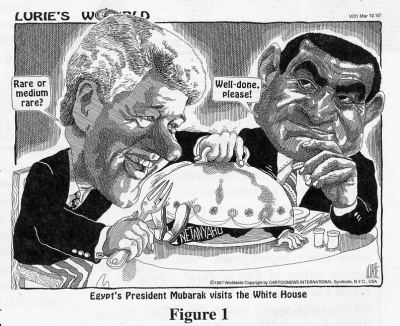
Although the cartoon unmistakably showed the American and Egyptian leaders joining together against their Israeli counterpart, one Egyptian cartoonist took great offense. On March 31, Gam'at Farhat published a cartoon in the prominent and sensationalistic Egyptian weekly Ruz al-Yusuf that purported to show what Lurie really meant: Clinton and Netanyahu about to carve up Yasir Arafat (fig. 2). In an accompanying article, Farhat directed a string of wild accusations against Lurie - that he had served in the French Foreign Legion in Algeria and then as an Israeli paratrooper during the 1967 War in Sinai, both times complicit in killing Arabs; that Anwar as-Sadat had banned this "rude Zionist artist" from entering Egypt; and that Lurie had offered his cartoons free of charge to Egyptian publications (implying a propagandistic intent).
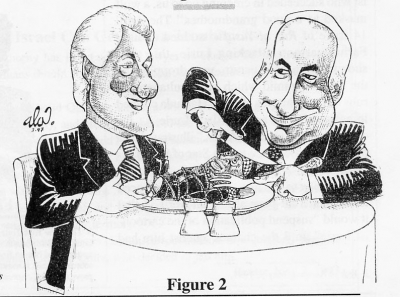
On April 5, Lurie's daily p. 6 cartoon in Al-Ahram was accompanied by his reply to Farhat's assault. Titled "I never fought in the Sinai and did not kill Egyptian prisoners of war," it included a detailed fifteen-point rebuttal about his own biography and bibliography.
Al-Ahram's willingness to publish Lurie's defense spurred a furious response. Nineteen Egyptian cartoonists wrote a petition against Lurie: "the employment of Lurie does not comply with the decisions of the Journalists' Association to boycott Israel." 'Adil Hamuda, deputy editor of Ruz al-Yusuf, added to Farhat's accusations in the April 7 issue of his magazine, raging against the "Israeli artist who succeeded in creeping up to us, a wolf masked as a good grandmother." The April 14 issue of Ruz al-Yusuf contained another Farhat cartoon attacking Lurie, this time showing him as a paratrooper dropping on the Great Pyramid which he simultaneously rubs out with his pen (fig. 3). Hamuda chimed in again, with an article titled "Lurie . . . the charlatan artist who kills Arabs," illustrated by a picture of Lurie's face with a Star of David superimposed over it (fig. 4).
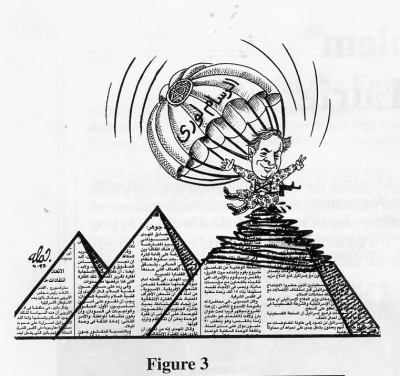
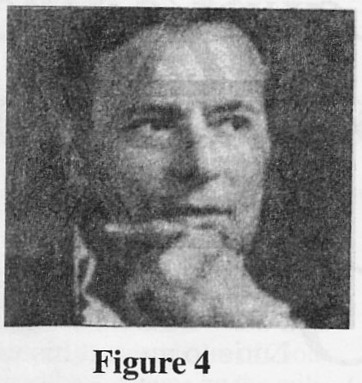
Bowing to this fury, Al-Ahram announced in another front-page article on April 14 that it would "suspend publication of the cartoonist Lurie" until the charges against him had been proven, "and especially his involvement in making war on the Arabs." Interviewed the same day, Al-Ahram's managing editor Muhammad 'Abd al-Mun'im conceded that the more lurid charges against Lurie would be proven wrong but said his newspaper found it impossible "to stand as one against so many."
Two weeks later, on April 28, Farhat further revealed his views by publishing a cartoon in Ruz al-Yusuf that showed an Orthodox Jew standing on a pile of New York Times and undressing the Statue of Liberty (fig. 5). Meanwhile, Lurie sought to sue Ruz al-Yusuf but found no Egyptian lawyer would represent him because, as he put it, "they can't work for an Israeli."
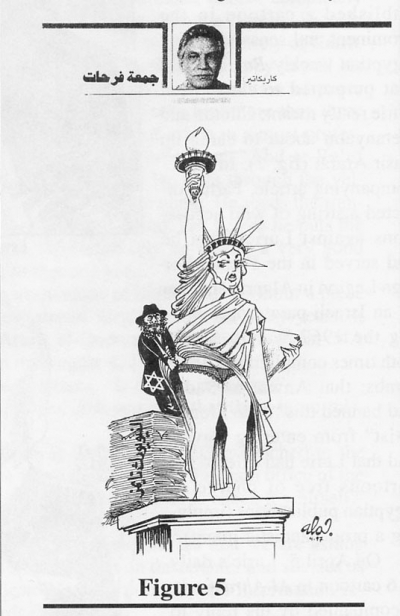
And that was it. Despite the remorse of some Egyptians and considerable international attention, Lurie's three weeks in Al-Ahram came to an end, with little prospect of renewal, a small but revealing casualty of the unwillingness of Egypt's elite to normalize relations with Israel.
June 9, 2022 update: Ranan Lurie died yesterday in Las Vegas, age 90. He contributed a number of cartoons in the 1990s to the Middle East Quarterly.